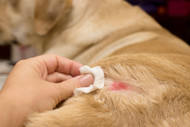Dog Dermatitis
Posted by Essential Dog on Mar 29, 2023
Dermatitis is a skin condition that commonly affects dogs. It is caused by various factors, including allergies, parasites, infections, and hormonal imbalances. Dermatitis can manifest in different ways, depending upon how severe the condition is and the underlying cause.
Types of Dog Dermatitis
Following are some common types of dermatitis that affect dogs:
Allergic Dermatitis - Allergic dermatitis is caused by an allergic reaction to environmental allergens like pollen, dust mites, and molds. Symptoms include itching, redness, and recurrent skin infections. Treatment may involve medication, lifestyle changes, and regular bathing.
Contact Dermatitis - Contact dermatitis is caused by direct contact with irritants such as detergents, shampoos, or chemicals. Symptoms may include redness, itching, and blisters. Treatment involves identifying and avoiding the irritant and applying topical creams to soothe the skin.
Bacterial Dermatitis - Bacterial dermatitis is caused by a bacterial infection that affects the skin. Symptoms may include redness, swelling, and pus-filled bumps. Treatment involves antibiotics, and in some cases, surgical intervention may be necessary.
Fungal Dermatitis - Fungal dermatitis is caused by a fungal infection that affects the skin. Symptoms may include circular patches of scaly skin, hair loss, and itching. Treatment involves antifungal remedies and thorough cleaning of the dog's environment.
Seborrheic Dermatitis - Seborrheic dermatitis is a condition that affects the skin's oil glands, causing scaly patches and excessive oil production. Treatment involves specialised shampoos and regular grooming.
Autoimmune Dermatitis - Autoimmune dermatitis is a condition in which the dog's immune system attacks its own skin. Symptoms may include redness, scaling, and crusting. Treatment may involve remedies to suppress the immune system and manage symptoms.
Parasitic Dermatitis - Parasitic dermatitis is caused by external parasites such as ticks, fleas and mites. Symptoms may include itching, hair loss, and skin irritation. Treatment involves eliminating the parasites and preventing infestation through regular flea and tick control.
Symptoms
The symptoms of dog dermatitis can vary depending on the underlying cause of the condition. Common symptoms may include itching, redness, bumps or rashes, hair loss, scaly or flaky skin, and a foul odor. Dogs with dermatitis may also be more prone to skin infections, which can worsen their symptoms.
Treatment
Prevention and early intervention are key in managing dermatitis in dogs. Owners should be aware of the common types of dermatitis and take steps to prevent them, such as regular grooming, flea and tick control, and avoiding irritants. They should also be vigilant for signs of skin irritation, such as excessive scratching or biting, redness, or bumps, and seek veterinary treatment promptly.
Treatment for dog dermatitis will depend on the cause of the condition. If the dermatitis is caused by allergies, treatment may involve identifying and avoiding the allergen, medication to manage symptoms, and regular bathing to reduce skin irritation. For bacterial or fungal dermatitis, antibiotics or antifungal medication may be prescribed, and in severe cases, surgical intervention may be necessary. Parasitic dermatitis can be treated with flea and tick control medication and regular grooming to remove any parasites on the dog's skin.
Conclusion
In conclusion, dermatitis is a common skin condition that affects dogs and can be caused by a variety of factors. Common types of dermatitis include allergic, contact, bacterial, fungal, seborrheic, autoimmune, and parasitic. Prevention and early intervention are essential in managing dermatitis, and owners should take steps to prevent skin irritation, seek prompt veterinary attention when necessary, and maintain good skin health through regular grooming and flea and tick control.

